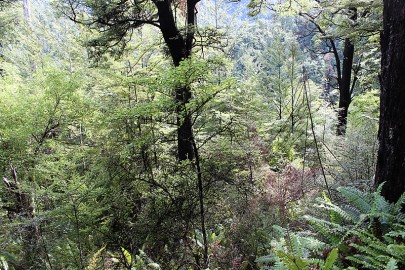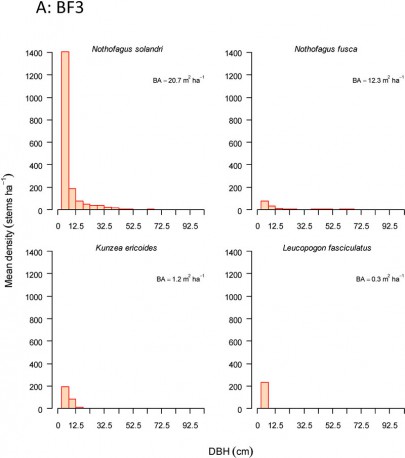Nothofagus solandri - (N. fusca) / Coprosma microcarpa - Leucopogon fasciculatus forest
In this section
Common name: Black/mountain beech forest Code: A: BF3

Co-occurrence of [Nothofagus solandri], [Griselinia littoralis] (shown here in the subcanopy), [Coprosma microcarpa] (shown here in the understorey foreground) and [Coprosma linariifolia] indicates that the stand belongs to this alliance.Mt. Richardson, Canterbury Foothills.
Where does it occur?
This 166 000 ha alliance was found primarily on the eastern South Island north of 45°S, at altitudes from 340– 820 m, and in the central North Island, at altitudes from 760–1140 . It occurs primarily on faces and ridges, with slopes ranging from 13–38 degrees.Sites are among the driest of any alliance (mean annual precipitation = 1440 ± 51 mm).
Description
The canopy is dominated by Nothofagus solandri with Nothofagus fusca and N. menziesii sometimes co-dominant. Coprosma microcarpa, Leptecophylla juniperina and Leucopogon fasciculatus dominant in the subcanopy. Diagnostic species primarily occur in the understory (<2 m tall) and include Coprosma linariifolia and C. microcarpa. In the ground layer frequent diagnostic species are Lagenifera strangulata and Corybas trilobus, and occasionally Uncinia scabra. The most frequent epiphytes are broadleaf, Grammitis billardierei, Pyrrosia eleagnifolia, Hymenophyllum sanguinolentum and Asplenium flaccidum. Species richness is moderate with on average 33 species per plot, with over half of these (19) being measurable tree species. Ferns are relatively common in this class, comprising on average five species per plot (40% of the total species richness). The proportion of the total species richness that is exotic is typically low (mean = 1, range 0–3), with the tree Douglas-fir (Pseudotsuga menziesii) being the most notable exotic, and Mycelis muralis the most frequent. Very few graminoids are present. The proportion of the total species richness comprised of ferns species is typically low (mean = 7 per plot, range 0–13), the most frequent of which are Grammitis billardierei, Blechnum procerum, and Asplenium flaccidum. This class is especially important in the provision of substrate suitable for insect-foraging birds.

A: BF3 size structure of canopy dominants.
Indicator species
Co-occurrence of Nothofagus solandri, Coprosma microcarpa, Coprosma linariifolia and Griselinia littoralis OR
Nothofagus solandri, Coprosma microcarpa, Coprosma linariifolia and Carpodetus serratus OR
Nothofagus solandri, Coprosma microcarpa, Carpodetus serratus and Leptecophylla juniperina
Stand characteristics
| Mean canopy height (m): | 17 m (range 4–33) |
| Mean stem density (stems/ha): | 3275 (603) |
| Mean basal area (m2/ha): | 41 (2.7) |
Synonyms
| Relationship | Name | Author |
|---|---|---|
| overlaps with | Beech forests: Central and southern South Island | Wardle (1991) |
| overlaps with | Beech forests: northern South Island | Wardle (1991) |
| overlaps with | Beech forests: North Island axial ranges | Wardle (1991) |
| overlaps with | Beech forests: other beech stands of the North Island | Wardle (1991) |
| overlaps with | Mountain beech forest | Singers & Rogers (unpublished) |
| broadly equivalent to | Black beech forest | Singers & Rogers (unpublished) |
Nothofagus solandri / Griselinia littoralis – Coprosma microcarpa – C. linariifolia forest
![[Nothofagus solandri], [Griselinia littoralis] (shown here in the subcanopy), [Coprosma microcarpa] (shown here in the understorey foreground) are important components of this association. [Nothofagus solandri], [Griselinia littoralis] (shown here in the subcanopy), [Coprosma microcarpa] (shown here in the understorey foreground) are important components of this association.](/assets/Publications/Woody-ecosystem-types/Nothofagus_solandri_Griselinia_littoralis_Coprosma_microcarpa__ResizedImageWzQwNSwyNzBd.jpg)
[Nothofagus solandri], [Griselinia littoralis] (shown here in the subcanopy), [Coprosma microcarpa] (shown here in the understorey foreground) are important components of this association.
Common name: Black beech forest with broadleaf and coprosma species
Code: a: BF5
Where does it occur?
This 60 500 ha association has only been sampled on the South Island in montane areas of North Canterbury and in the Richmond Range. Sites range from flat to steeply sloping (50º). Altitudes range from 220 to 1110 m.
Description
On average stands are 14 m tall, but may be up to 30 m tall.These forests have on average 25 species recorded on a plot. Only 5% of these, on average, are exotic.
Nothofagus solandri / Pseudopanax crassifolius – Leucopogon fasciculatus – Coprosma rhamnoides – Leptocophylla juniperina forest
![[Leptocophylla juniperina] is common in the understorey of this association. [Leptocophylla juniperina] is common in the understorey of this association.](/assets/Publications/Woody-ecosystem-types/Leptocophylla_juniperina_common_understorey__ResizedImageWzQwNSwyNzBd.jpg)
[Leptocophylla juniperina] is common in the understorey of this association.
Common name: Black/mountain beech forest with lancewood and mingimingi
Code: a: BF6
Where does it occur?
This 30 200 ha association has been sampled on the South Island in montane areas of North Canterbury and in the Nelson-Marlborough Region and in the North Island in the Tararua, Kaweka and Kaimanawa ranges. Sites range from gentle (5º) to steeply sloping (50º). Altitudes generally range from 400 to 800 m, although this association has been observed on sites as low as 100 m and as high as 1100 m.
Description
This forest association is, on average, 18 m tall but can range from 4 to 32 m. It tends to be species poor with an average of 20 species on a plot which can reach 44. On average, there are few (less than 3%) exotic species present.
References
Wiser, S.K., Hurst, J.M. 2010. Composition and structure of 24 New Zealand forest and shrubland vegetation communities. Landcare Research Contract Report LC0910-073. Prepared for the Department of Conservation and the Sustainable Management Fund of the Ministry of Agriculture and Forestry.
Wiser, S.K., J.M. Hurst, R.B. Allen, E.F. Wright. 2011. New Zealand’s forest and shrubland communities: a classification based on a nationally representative plot network. Applied Vegetation Science 14: 506-523.
Wiser, S.K.; De Cáceres, M. 2013. Updating vegetation classifications: an example with New Zealand's woody vegetation. Journal of Vegetation Science 24: 80-93.
De Cáceres M, Legendre P, Wiser SK, Brotons L (2012) Using species combinations in indicator value analyses. Methods in Ecology and Evolution 3(6): 973-982.



